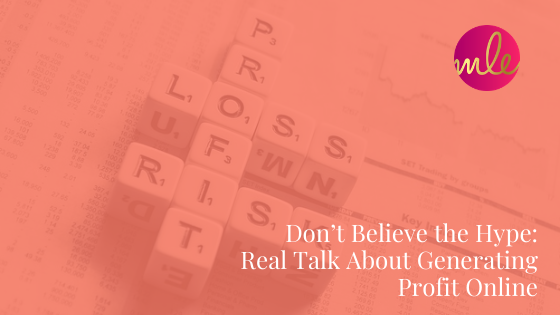
Episode 115: Don’t Believe the Hype: Real Talk About Generating Profit Online
How many times have you seen someone in a Facebook group celebrating their launch success?
We’ve all heard people shouting from the rooftops about their launch numbers. They’ll write a glowing social media post that says something like: “HEY! Wanted to share some great news! My latest launch was a huge success! 100 people purchased and I did $150,000 in sales!”.
Just to be clear, I am HERE for everyone’s success. I love celebrating as much as the next person because anyone who has success just proves that we can have success too.
Here’s the thing…there’s a big difference between REVENUE and PROFIT.
Revenue is the amount of money you bring in. So, if you make 100 sales of a $1500 offer, that $150,000 is your revenue. And it’s worth celebrating as 100 people bought from you and that is AMAZING.
But your profit is very different.
Profit is that revenue number MINUS what it costs to make that revenue number. So in this case, if this person made $150,000 in sales BUT it cost $130,000 to make those sales, the profit was $20,000.
Sure, $150,000 is a revenue number most people would love to get… BUT they’re not actually profiting $150,000, right?
Revenue and Profit: What’s the Difference?
It’s important to know the difference between revenue and profit because it’s easy to overinvest in things when you don’t know what’s draining your profit. In fact, I went through an example last week all about this and if you haven’t listened to episode 114, I highly encourage you to go back and listen as I share how to break down your costs.
It’s also good to know because many times people shout from the rooftops their REVENUE number and people think it’s their profit number.
Those two things are VASTLY different, and that’s exactly why I wanted to talk about the differences between revenue and profit to help you get a better handle on things.
For example, back in September I had a new client who came to me for help. She’d had a great year in terms of generating revenue, but couldn’t figure out why she was broke. The numbers just didn’t make sense!
This is a common scenario and if you’re dealing with this issue please know just about every single business owner I’ve ever talked with runs into this.
In my new client’s case, she had been running a marketing funnel that her team created and doing Facebook ads with another person. She wanted me to check everything out to see if I could do any better because she was making sales but every month she was ending up short of cash and couldn’t understand why.
If you’ve ever run paid ads or are thinking about paid ads let’s dive into this because it’s an important conversation to have. Plus, it will help ensure that you don’t overspend on marketing.
 Where to Begin
Where to Begin
First thing first, I always lay out my client’s marketing funnel so that I understand the touch points they take their audience through because that plays into the ads needed and the ad spend needed.
Second, I have a Facebook ads calculator that I use to help my clients understand the benchmarks we need to hit to stay on track to profitability. I always run through this with potential clients so they can understand if running ads makes sense or not AND so we have clear numbers to hit to ensure we stay on track to profitability. It’s all too easy to get distracted by numbers that don’t directly affect profitability, like the number of comments or number of clicks versus opt ins or sales.
Finally, if a client comes to me after running a launch or an advertising program with someone else that didn’t do very well OR they’re not sure where their money went, I start by taking them through my Promotional Debrief. This is something I encourage ALL clients and EVERY SINGLE BUSINESS out there who does paid advertising to do because it’s eye-opening to see what your actual numbers are. It gives you the data to make better decisions.
This is what the break down looks like:

Breaking Down the Numbers
Now, let’s run through the highlights here because this is incredibly important data that will help you make better decisions on your marketing spend.
Time Period
To begin, we need to take a look at a specific period of time. For clients who have a launch, that starts with the pre-launch period all the way through cart close, and then we come back after the refund period and adjust based on any refunds that came through.
For clients who run evergreen promotions, we typically look at a 30-day period once the testing phase is done and the campaign is optimized and running ongoing.
Revenue Generated
Once we’ve determined our time period, we look at the total revenue generated during the promotion. This is the total dollar amount that you received from people buying your offer.
Total Customers and Launch List
Next up, we look at total customers who purchased and the ‘launch list’ size — people who are in your marketing funnel and actively going through your promotional period.
These numbers help us understand the profit per customer and the number of people we need on a launch list to hit this number. These are all critical numbers to know as you make decisions about spending money to market your business.
Earnings Per Lead
After that we calculate earnings per lead. Earnings per lead is an important number when you’re using paid marketing — or really any marketing, but definitely paid marketing — because you want to know if you’re losing money or making money on these leads.
Let’s look at it like this. If it costs you $10 to attract a lead and you make $20 per lead, that’s good. If it costs you $20 per lead and you only make $10 per person, that’s a money pit that will drain your bank account fast.
I’m simplifying it here assuming that you’ve only got one offer, as it can get a little more complicated if you have upsells and downsells and other things. But for now, we’re keeping it simple.
In this example to get your earnings per lead number, you’ll take the total revenue generated and divide that by the total launch list size.
Making the Math Add Up
Armed with those numbers, we need to work the numbers.
Let’s say the total revenue generated was $5,000 and the list size was 100 people. We’d take the $5,000 and divide by 100 people to come up with $50 per lead. (So far, so good.)
Next we’d go into cost per lead. For simplicity’s sake, I’m going to say that all 100 leads came from Facebook but in reality they could come from different places like affiliates, organic traffic, referrals and so on.
Let’s keep it simple and say 100 leads came from Facebook and that you spent $1500 on Facebook ads. So your cost per lead is $15 which is $1500 Facebook ad costs divided by 100 leads.

Here’s what we know so far:
- We spent $1500 on Facebook ads
- We made $5,000 from 10 buyers
- Our earnings per lead is $50
- Our cost per lead is $15
- Currently our profit margin is running at 70% with $3500 in our profit bucket
Sounds pretty good and profitable, right? But wait just a minute because this is where people get caught up and overinvest and overlook hidden costs. That’s exactly why it’s so darn important to have the whole picture in front of you.
Next, let’s go into the team support and tools specifically for this promotion. This is where it can get a little tricky, but again, I’m going to keep it simple for us with this example. We need to look at the team support needed to create this profit. For the new client I was talking with, this is where her profit hole was happening.
Here’s what you should consider with regards to support and tools:
- Team: Team support could include your Facebook ad specialist, your graphic designer, your copywriter, your VA, your launch manager, your business manager, your website specialist and more. The cost to have your team support you for this promotion should be included here.
- Tools: If you have special tools, reporting and/or hosting that you need for this promotion, those costs should be included as well.
- Affiliate: If you have any affiliates, those costs should be included as well.
- Miscellaneous: Sometimes clients have special additional costs like shipping or travel expenses or other things. Again, if that goes into your sale, it should be included.
With our fictional example I’m running through, let’s say the team support adds another $2,500 in costs and there was a special webinar platform for this promotion that was $79, plus two affiliate sales at $250 each which is another $500.
These are the costs that are so often overlooked… but as you’re about to see, they can REALLY eat into your profit!
So now, we’ve got total revenue of $5,000 and total costs with Facebook, team support, webinar platform and affiliate payments of $4,579, leaving just $421 in profit. OUCH!

And then let’s say two people ask for a refund for a total of $1,000.
Now you’re running NEGATIVE $579. Suddenly the $5,000 revenue number has been eaten up by hard costs and refunds.

The Hard Truth and the Good News!
When you look at this example and see there’s little to no actual profit it can be shocking. But trust me when I say this happens ALL THE TIME. It’s so easy to get focused on the revenue number and overlook what it takes to make that revenue number.
The good news here is that knowledge is POWER. Once you know these numbers, you’re able to drive a profitable business and make decisions from a place of power.
This happened with that client I told you about. Once we ran through a couple months of her promotion with the numbers, we identified the big profit leaks and could stem that flow — so we turned her business from losing money every month to turning a profit.
Now she’s much more empowered in the process because every month she has a view into what’s working, what’s not working and is able to make a better decision about what comes next.
After seeing the math in action, I’m going to challenge you to start collecting some of this information for your marketing.
What’s going into your promotional activities? Are you making a profit or losing money? What’s the difference between your profit number and your revenue number?
Did the difference surprise you?
Once you do that, congratulate yourself. This is the not-so-sexy part of business that most people skip over, but this is the part of creating Profit Without Worry in your business.
Let me know how this goes for you!
I’d love to hear from you! What a-ha’s did you get from running your profit numbers?
Hit me up on social media OR email me – michelle@michellelevans.com
Create Profit Without Worry – one system at a time. I’ll show you how to attract a steady flow of buyers without all the hustle with this free download → 5 Steps To Profit Without Worry.
Links mentioned in this episode:
- Link to podcast episode 114 (INSERT LINK)
- Borrow My Brain and get your own Promotional Debrief – apply here
- Connect on Facebook
- Connect on LinkedIn
- Connect on Instagram
- Create Profit Without Worry – one system at a time with this free download → 5 Steps To Profit Without Worry.



